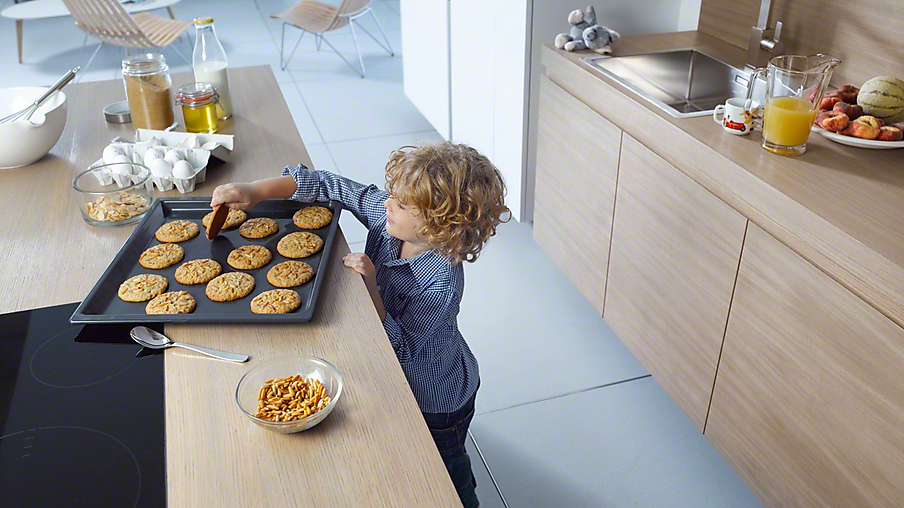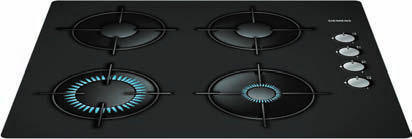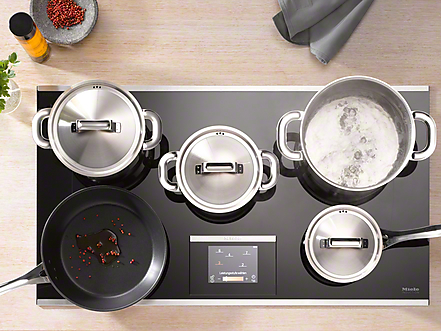Kitchen, Oven & Cooktops: What to look for & what to choose
It brings out scents and aromas. It fills the family table with food and sweets. It is the protagonist appliance of the kitchen. Do we really know everything about the uses and capabilities that today's kitchen offers, or have we fallen behind in technological advances? It's time to update our knowledge by learning the latest information about modern kitchens, ovens, and cooktops.

And we start with the basics: The most basic distinction in kitchen types is the position in which it will be placed. So, we have non-built-in freestanding kitchen appliances and built-in appliances.
Independent, non-built-in kitchens
The "traditional" and well-known to all of us kitchen with the oven and the cooktops on top, is placed freely between the kitchen countertops. Most of us have grown up with this type of kitchen at home, with the characteristic storage drawer where mom would put the baking trays and other utensils.
It is preferred more in older households, where space has been left for its placement between the kitchen cabinets. However, some of the expensive semi-professional or professional kitchens available on the market (which can also be purchased for home use) are non-built-in.
Built-in appliances
If we choose built-in appliances, as modern kitchen architecture dictates, we need to make a series of other small decisions.
- First of all, we need to decide where our appliances will go. The cooktops are always placed on the countertop, but as for the oven, there are different options. At what height do we want to place it? In a tall column, to have access without bending? Or low, under the countertop?
- Then, we need to decide whether we want to buy the oven separately from the cooktops or buy them together (as a set).
So when we want to search for appliances and do our market research, we are called to decide if we want a countertop oven or an under-counter oven, and then if we want it with cooktops or without.
Therefore, the 4 available options for ovens, in terms of their placement, are:
Built-in Countertop Oven with Cooktops The oven operates independently of the cooktops and can be placed in a different location from them. It has its own switches for oven operation, while the cooktops that accompany it have their own switches.
Built-in Countertop Oven with Burners It has separate controls for both the oven and the burners. Therefore, it must be installed directly under the burners, so that they can be connected. This oven has more controls compared to the corresponding countertop models.
Types of Burners
Let's now see what types of cooktops exist and their most important differences, starting with the burners.
Ceramic
They are preferred for their shiny and high-tech appearance. They provide even heat distribution, while their smooth ceramic surface is easy to clean (always following the manufacturer's instructions). They are relatively sensitive and require some care to avoid scratches.
Gas
They are preferred by most professional chefs. One of their biggest advantages is that their flame is visible, so you can see its size and adjust it instantly.

However, not all gas burners are the same. Professional chefs use high-power burners, which are difficult to compare with domestic ones. Always compare the power (watt or kilowatt) of the different burners available before making your final choice.
Most gas burners come with two sets of nozzles, so they can be connected either to a gas cylinder or to the natural gas supply of the area.
Induction
They are the latest in cooking technology. While they look very similar to ceramic cooktops, they function completely differently. The innovation lies in the fact that the cooktops themselves do not heat up, but rather the base of the cookware. By placing the cookware on the cooktop, a magnetic field is created that causes the vibration of the metal molecules and thus heats up the cookware.

Some advantages include:
Minimal energy consumption, precise temperature control, and faster food preparation as there is no need to wait for the cooktop to heat up.
Easier cleaning, as only the cookware heats up and not the surface. The surface temperatures remain low, so any residues or splatters do not burn and can be easily removed.
Safety: if you forget to place a cookware on the cooktop, no heat will be generated. If you remove the cookware from the cooktop, the function stops. The presence of high temperature on the cooktops is only because the hot cookware was touching there.
Disadvantages? Their higher cost compared to other options, as well as the fact that some of the existing cookware that has already been purchased may not be compatible with induction cooktops.
Emagie
The most "traditional" solution is also the most economical. We mainly find them in freestanding kitchens and less in built-in ones.
The cooking zones on emagie cooktops usually take a long time to heat up well. However, there are also fast ones, which take less time to reach the required cooking temperature.
Mixed
Combination of electric and gas cooktops in order to take advantage of the benefits of various types of cooktops.
You will also find domino cooktops on the market, which allow you to combine different types of cooktops, as well as a range of other appliances (e.g. grill) to create your own "puzzle" according to your needs.
Other features you need to explore:
- the power of the cooktops
- the diameter of the elements (make sure your largest cookware fits)
- the distance between the elements (can two of your largest pots fit side by side if you want to use them simultaneously?)
- Some cooktops have a safety lock, which ensures that the cooktop will not be activated by children, as well as an automatic device deactivation system in case it is left on.
Types of Ovens
The majority of ovens are electric, but there are also gas ovens for more economical baking. In mixed ovens, the oven works with gas, but the grill works with electricity.
As there are many options, the main question you need to answer is: How often do you use the oven?
And then there are a series of other questions, such as how many people are usually invited to cook for? What types of food do you cook in the oven? And of course, what is your budget?

One of the most important factors in choosing is, of course, the cooking methods offered by the appliance.
Programs / Cooking methods
Once upon a time, the top and bottom resistance and the grill were enough. Today, however, ovens have many more cooking methods, while cooking with hot air has become one of the most important additions to ovens in recent years.
The main advantage of cooking with hot air is that the air circulates better and more evenly inside the oven, so the food receives the same amount of heat no matter where it is.
However, some recipes are better completed in an oven with resistances. Therefore, an oven that offers both cooking methods is preferable.
Let's see the main operating modes that modern ovens provide for preparing our meals and desserts:
- Hot air
- Top and bottom resistance
- Bottom resistance
- Top resistance
- Large grill and small grill
- Combination of hot air and grill
- Automatic rapid preheating
- Defrosting
- Pizza baking
- Rotisserie
- Intensive baking
- Gentle baking
Depending on the way we are used to cooking and the use we make of our oven, we choose the model with the corresponding programs.
There are also devices that offer the ability to automatically adjust the most suitable cooking method, time, and temperature depending on the type of food. Additionally, several devices provide the ability to store favorite and tested cooking methods.
Another innovation in cooking is the use of steam. Steam ovens promise juicy food that retains its natural flavor and ingredients. However, there are also combination ovens that combine the functions of a steam oven with the conventional functions of an oven and meet all requirements.
Cleaning
Removing burnt food residues is sometimes a nightmare. However, modern technology in ovens promises spectacular results in the field of cleaning and self-cleaning of internal surfaces with minimal effort.
This is achieved thanks to the following functions:
- High-resistance internal surface made of non-stick enamel
- Foldable grill for easier cleaning of the oven ceiling
- Removable oven door for easy cleaning
- Door with internal surface made of glass for easy cleaning
- Special coatings on the back with self-cleaning capability
- Pyrolysis: Self-cleaning of the dirty chamber at high temperatures
- Hydrolysis: Self-cleaning of the dirty chamber using water
Safety
Modern devices have built-in child protection programs and have become so "smart" that you will never have to rush back from work because you forgot to close the oven.
Let's take a closer look at some options:
- Automatic shutdown if the operating time exceeds the maximum allowed limit
- Safety lock button to prevent children from operating the device
- Low temperature on the external glass of the door, thanks to multiple layers of thermal insulating glass, to prevent burns
Dimensions
The dimensions of the built-in oven in standard size are 60 cm by 60 cm. This oven usually meets the needs of an average family. However, there are also ovens available in smaller sizes, which means smaller capacity.
If you frequently cook for many people or a regular oven does not meet your needs, there is the option of a double oven (one oven on top of the other), and there is also the possibility of integrating a larger oven with a width of 90 cm.
In independent, non-built-in kitchens, you can find ovens in other dimensions as well.
Check if the largest baking tray you already have fits in the new oven you are considering to buy. This will help you compare the old and new oven, while avoiding any surprises if it is an expensive baking tray or casserole dish that you want to continue using.
Equipment
Each kitchen or oven comes with its standard equipment, and we can purchase various additional accessories for more capabilities. Most appliances come with 2 baking trays (one shallow, one deep) and of course, the grates.

The presence of telescopic arms that pull the baking tray out without the need to "dive" into the oven to check the progress of the food is very important.
Also, the integrated stop function on the rails is important to prevent the tray from falling out when it is pulled out.
Appearance - color
Most models today are available in silver color, which gives the feeling of "high technology" in our kitchen. However, appliances are still available in white color, especially in freestanding kitchens, and there are also options for those looking for other shades and original design in appliances and kitchen furniture.
Other features you can explore:
- Timer: Useful for programming the oven to start cooking while you are away, so you can find the food ready when you return, and also to avoid any accidents even if you are at home, if you generally tend to forget.
- Thermometer for roasts: No longer need to monitor the cooking process. The oven automatically shuts off when the roast reaches the desired temperature.
- Folding oven door: After opening the oven, the folding door sinks completely below the oven chamber, making it easier to use.
- As before purchasing any electrical appliance, make sure to check and compare the energy class among your options. Higher energy class equals lower electricity consumption.
Keeping the above tips in mind, explore the features that interest you in the Kitchens & Ovens category, do your market research on Skroutz, and find out which store offers the best prices. If you only want to buy cooktops, you can focus on the Cooktops category. Happy shopping!

Aspa Tsamadi
Aspa is a blogger at Aspa Online, where she captures moments of her daily life with her daughters and shares thoughts, ideas, and information. She is one of the most experienced moms in the Internet and blogging space, while engaging in various interesting activities and undertaking some exceptional projects for the Greek internet, such as organizing the event "Digital Neighborhoods" for parent bloggers.









